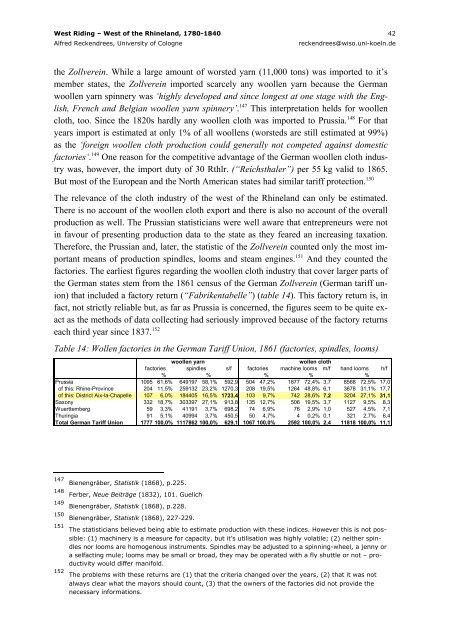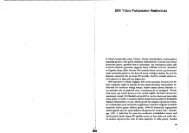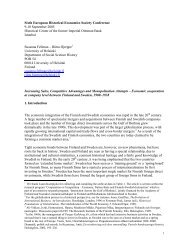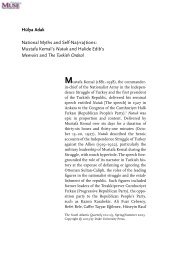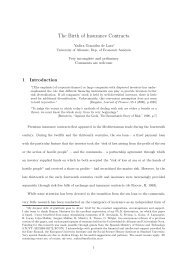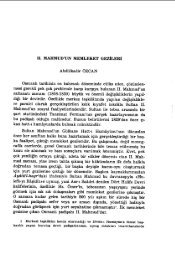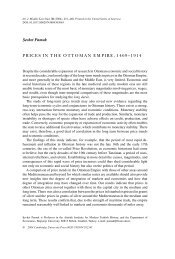West Riding – Western Rhineprovince, 1790-1840: Diverse Paths to ...
West Riding – Western Rhineprovince, 1790-1840: Diverse Paths to ...
West Riding – Western Rhineprovince, 1790-1840: Diverse Paths to ...
Create successful ePaper yourself
Turn your PDF publications into a flip-book with our unique Google optimized e-Paper software.
<strong>West</strong> <strong>Riding</strong> <strong>–</strong> <strong>West</strong> of the Rhineland, 1780-<strong>1840</strong> 42<br />
Alfred Reckendrees, University of Cologne reckendrees@wiso.uni-koeln.de<br />
the Zollverein. While a large amount of worsted yarn (11,000 <strong>to</strong>ns) was imported <strong>to</strong> it’s<br />
member states, the Zollverein imported scarcely any woollen yarn because the German<br />
woollen yarn spinnery was ‘highly developed and since longest at one stage with the English,<br />
French and Belgian woollen yarn spinnery’. 147 This interpretation helds for woollen<br />
cloth, <strong>to</strong>o. Since the 1820s hardly any woollen cloth was imported <strong>to</strong> Prussia. 148 For that<br />
years import is estimated at only 1% of all woollens (worsteds are still estimated at 99%)<br />
as the ‘foreign woollen cloth production could generally not competed against domestic<br />
fac<strong>to</strong>ries‘. 149 One reason for the competitive advantage of the German woollen cloth industry<br />
was, however, the import duty of 30 Rthlr. (“Reichsthaler”) per 55 kg valid <strong>to</strong> 1865.<br />
But most of the European and the North American states had similar tariff protection. 150<br />
The relevance of the cloth industry of the west of the Rhineland can only be estimated.<br />
There is no account of the woollen cloth export and there is also no account of the overall<br />
production as well. The Prussian statisticians were well aware that entrepreneurs were not<br />
in favour of presenting production data <strong>to</strong> the state as they feared an increasing taxation.<br />
Therefore, the Prussian and, later, the statistic of the Zollverein counted only the most important<br />
means of production spindles, looms and steam engines. 151 And they counted the<br />
fac<strong>to</strong>ries. The earliest figures regarding the woollen cloth industry that cover larger parts of<br />
the German states stem from the 1861 census of the German Zollverein (German tariff union)<br />
that included a fac<strong>to</strong>ry return (“Fabrikentabelle”) (table 14). This fac<strong>to</strong>ry return is, in<br />
fact, not strictly reliable but, as far as Prussia is concerned, the figures seem <strong>to</strong> be quite exact<br />
as the methods of data collecting had seriously improved because of the fac<strong>to</strong>ry returns<br />
each third year since 1837. 152<br />
Table 14: Wollen fac<strong>to</strong>ries in the German Tariff Union, 1861 (fac<strong>to</strong>ries, spindles, looms)<br />
woollen yarn wollen cloth<br />
fac<strong>to</strong>ries spindles s/f fac<strong>to</strong>ries machine looms m/f hand looms h/f<br />
% % % % %<br />
Prussia 1095 61,6% 649197 58,1% 592,9 504 47,2% 1877 72,4% 3,7 8568 72,5% 17,0<br />
of this: Rhine-Province 204 11,5% 259132 23,2% 1270,3 208 19,5% 1264 48,8% 6,1 3678 31,1% 17,7<br />
of this: District Aix-la-Chapelle 107 6,0% 184405 16,5% 1723,4 103 9,7% 742 28,6% 7,2 3204 27,1% 31,1<br />
Saxony 332 18,7% 303397 27,1% 913,8 135 12,7% 506 19,5% 3,7 1127 9,5% 8,3<br />
Wuerttemberg 59 3,3% 41191 3,7% 698,2 74 6,9% 76 2,9% 1,0 527 4,5% 7,1<br />
Thuringia 91 5,1% 40994 3,7% 450,5 50 4,7% 4 0,2% 0,1 321 2,7% 6,4<br />
Total German Tariff Union 1777 100,0% 1117862 100,0% 629,1 1067 100,0% 2592 100,0% 2,4 11818 100,0% 11,1<br />
147 Bienengräber, Statistik (1868), p.225.<br />
148 Ferber, Neue Beiträge (1832), 101. Guelich<br />
149 Bienengräber, Statistik (1868), p.228.<br />
150 Bienengräber, Statistik (1868), 227-229.<br />
151<br />
The statisticians believed being able <strong>to</strong> estimate production with these indices. However this is not possible:<br />
(1) machinery is a measure for capacity, but it’s utilisation was highly volatile; (2) neither spindles<br />
nor looms are homogenous instruments. Spindles may be adjusted <strong>to</strong> a spinning-wheel, a jenny or<br />
a selfacting mule; looms may be small or broad, they may be operated with a fly shuttle or not <strong>–</strong> productivity<br />
would differ manifold.<br />
152<br />
The problems with these returns are (1) that the criteria changed over the years, (2) that it was not<br />
always clear what the mayors should count, (3) that the owners of the fac<strong>to</strong>ries did not provide the<br />
necessary informations.


